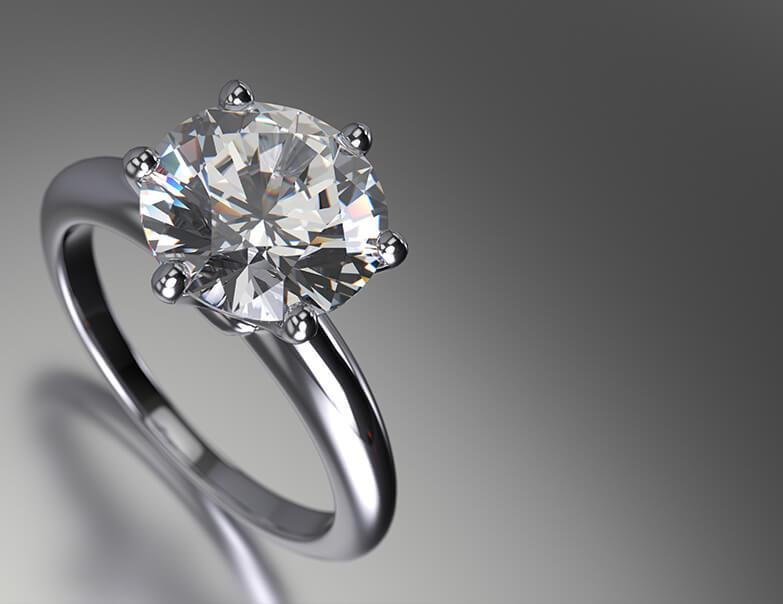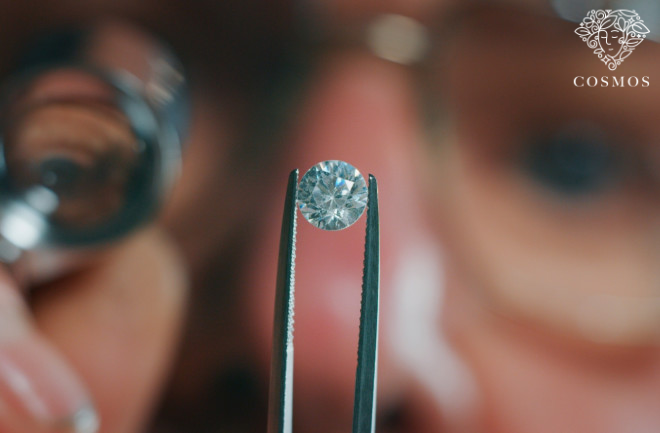A New Standard in Diamond Excellence
Cosmos diamonds are graded according to the traditional 4Cs (Cut, Color, Clarity, Carat) – but, in keeping with our trailblazing tradition, we've introduced an entirely new standard: the 5th C of Climate Neutral
Follow along as we break down The 5Cs, with diamonds grown and cut to the most exacting standards, carrying the mantle as the first fully traceable, 100% Climate Conscious Cosmos Diamond.
1. CUT
A DIAMOND’S CUT IS A MARK OF ITS CRAFTSMANSHIP, AND DIRECTLY IMPACTS ITS INTERACTION WITH LIGHT – CREATING BRILLIANCE, FIRE AND SCINTILLATION
The true and definitive mark of a diamond’s craftsmanship. Graded on a scale from Ideal to Poor, cut grade reflects how well a diamond was designed and crafted, and dictates the face-up appearance of the stone. It’s what leads to the Diamond Trifecta of Brightness, Fire and Scintillation (said differently: sparkle).
Cosmos diamonds are optimized for proportion, polish, depth and symmetry, and top the charts in Cut grades. It’s an art, and a science – we use a combination of computer imaging and artisan, hand-crafted work to optimize each and every diamond.
2. COLOR
THE GEMOLOGICAL INSTITUTE COLOR SCALE IS THE INDUSTRY STANDARD, STARTING AT ‘D’ FOR COLORLESS AND GOING DOWN IN THE ALPHABET FROM THERE
Defined in the 1950s by the Gemological Institute of America (GIA), this grading standard actually reflects the absence of color in a diamond. Representing the top of the scale, all Cosmos diamonds are Colorless or Near Colorless, and free of impurities.
An Insider Tip: The impression of color is impacted by a stone’s shape. Round Brilliant, Cushion and Princess diamonds appear brighter and whiter at a given grade, while we recommend going higher in the color scale for step-cut stones (like Emeralds and Asschers) or pointed Fancies (like this year’s trending Marquise, and the always stunning Pear).
3. CARAT
A REFLECTION OF A DIAMOND’S WEIGHT, AND CLOSELY TIED TO ITS APPARENT SIZE, THE HIGHER THE CARAT NUMBER, THE MORE RARE THE STONE
A measure of a diamond’s weight, this grade also reflects the apparent size of your gemstone. Fun Fact: The concept was originally defined when early traders used carob seeds to counterweigh their scales – now, a carat is universally defined as 200 milligrams.
Cosmos diamonds are available across all size ranges, with a focus on 2, 3 and 4 carats, even setting records at 9 carats and greater. In comparison to earth-mined counterparts of the same price, our created diamonds are a higher carat weight, and higher quality – a win-win.
4. CLARITY
EVERY DIAMOND IS UNIQUE, AND THIS GRADING REFLECTS THE PRESENCE OF WHAT ARE KNOWN AS INCLUSIONS – INTERNAL CHARACTERISTICS THAT MAY AFFECT THE STONE’S APPEARANCE
The GIA Clarity scale contains 11 grades, ranging from Included to Flawless. To determine a clarity grade, the grading laboratory takes into the account the size, nature, position, and quantity of inclusion characteristics using a 10× loupe for magnification.
Cosmos processes enable us to optimize for Clarity as we shepherd each individual diamond through its growth at our state-of-the-art Washington, D.C. laboratory. We specialize in grades from Very Slightly Included to Internally Flawless.
5. Climate Neutral
ABOVE AND BEYOND CARBON CONSCIOUS, 5TH C CERTIFICATION REFLECTS THE ACHIEVEMENT OF NET ZERO GREENHOUSE GAS EMISSIONS, INCLUDING ALL LEGACY IMPACTS
A company’s total climate impact is made up of not only its annual carbon emissions, but all past greenhouse gas emissions, many still present in the atmosphere today. To become Climate Neutral, a step beyond Carbon Neutral, this 'legacy' footprint must be addressed via offsets and mitigation efforts.
For Cosmos to define and achieve The 5th C of Climate Neutrality, we made sustainability and offset by planting trees more than 10X our climate footprint. With the purchase of a Grown in India, Cosmos diamond, you’ll not harm the climate, nor your pocket, with our affordable Luxury as vision for sustainable India.





Leave a comment
All comments are moderated before being published.
This site is protected by hCaptcha and the hCaptcha Privacy Policy and Terms of Service apply.